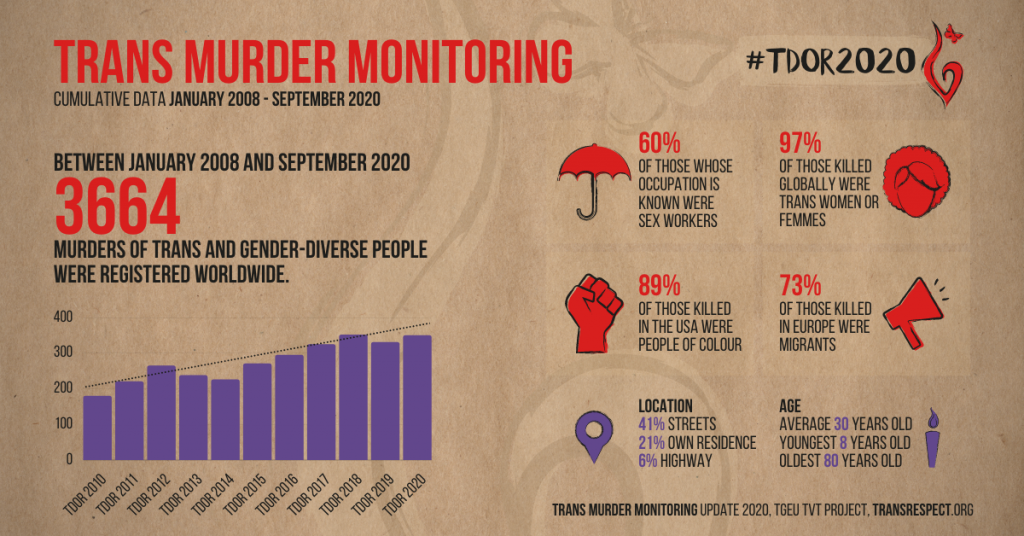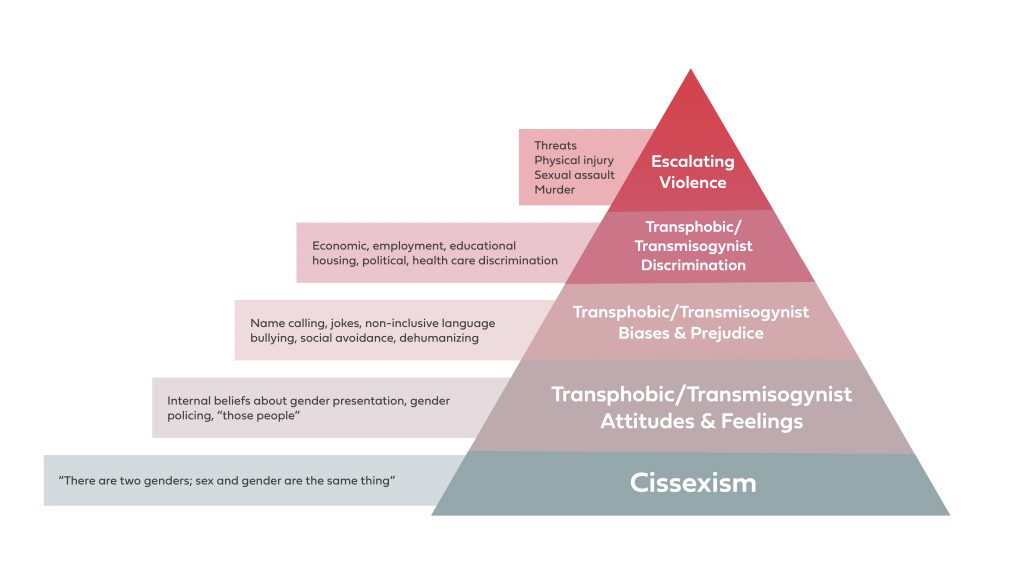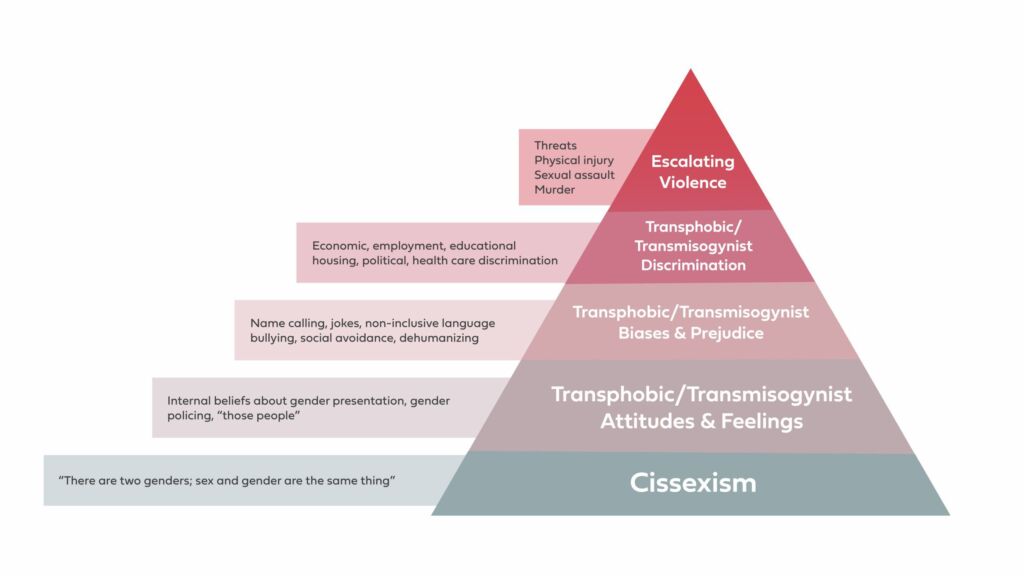A few years ago, the idea of “straight pride” had its moment in the sun. Hetero cis men took to their various soapboxes and asked why, if 2SLGBTQ+ folks had Pride events, were there not equivalent events for heterosexuals? Similar arguments regrettably, but unsurprisingly, have been made comparing Black History Month and the absence of a white history month.
I think about “straight pride” in the lead up to the Transgender Day of Remembrance (TDoR) every year because one of the many things the arguments for this counter-celebration was missing is an understanding of the other side of Pride celebrations: our grief.
2SLGBTQ+ folks have Pride events, yes. We also have candlelight vigils. Most notably, we have an annual event to honour and hold grief for our transgender community members who have been killed because of transphobia and transmisogyny.
Transrespect versus Transphobia Worldwide’s (TvT) 2020 update “reveals a total of 350 trans and gender-diverse people [were] registered murdered between 1 October 2019 and 30 September 2020, representing a 6% increase in reported murders from the 2019 update.” The TvT team further acknowledges that during the COVID-19 pandemic, and in light of growing racism and police brutality, trans and gender-diverse people face greater and growing danger, particularly trans folks who facing multiple forms of systemic oppression due to race, immigration status, poverty, etc..

Between January 2008 and September 2020, the murders of 3,664 trans and gender-diverse people were recorded worldwide. This is why we grieve every November.
But I want to address the cis people today.
And I want to specifically highlight for you the many trans and gender-diverse folks that are still here. I would like to invite cisgender folks to spend TDoR thinking about how you can commit to keeping trans and gender-diverse folks safe in the future.
Moreover, this TDoR, I invite cis people to consider the Pyramid of Cissexism¹. It is far too easy for many cis people to absolve themselves from not being complicit in the deaths of transgender and gender-diverse people. It is much less easy to disentangle from cissexism: the life force of transphobia and transmisogyny, and the foundation of the violence we mourn today.

This summer, Dr. Akilah Cadet frequently reminded white people that ending racism was not work for Black people to do. Ending white supremacy is work for white people to take on. Similarly, the work of addressing and ending cissexism is not work for transgender and gender-diverse people to do. Absolutely, cisgender people need to take their cues from the folks they’ve harmed. But the work itself, the sweat equity, needs to come from the cis side of the equation.
Fortunately there are incredible trans activists who are speaking out and creating valuable resources to help cis allies do this work (check out our Instagram story today for links to folks to follow). As a starting point, I’ve compiled a quick list of TDoR activities below for cis allies to take on. They range from things you can implement every day to bigger picture activities that will take some more planning. Whatever you choose to start with, the important thing is that you take up this work. On November 20, transgender and gender-diverse folks mourn and cis allies need to get to work.
Every day actions
- Use the correct pronouns. When meeting someone for the first time, ask for their pronouns (note, pronouns are not “preferred pronouns”). If someone in your life has recently changed their pronouns or if you are not used to using they/them, zie/zir, ey/eir as singular pronouns, you will likely make mistakes. Make a genuine apology that doesn’t centre on your feelings; commit to doing better and move on. Remember: using correct pronouns is suicide prevention. It is active allyship. It is literally the bare minimum.
- Follow transgender and gender-diverse people on social media. Amplify transgender and gender-diverse voices. Remember that following is just that: watching, listening, learning, and amplifying. It is not sliding into DMs for emotional labour or playing the devil’s advocate in the comments. This one is nice and easy which is good because the next one is a bit bigger.
- Prepare for uncomfortable conversations. Do you know someone who deadnames celebrities? Or continually misgenders trans people? It’s time to have the talk. It’s going to be uncomfortable. But I promise that trans lives are worth a bit of sweat above your lip. The price of admission to the ally park is feeling a bit queasy when you tell someone that they can’t continue to perpetuate harm against the marginalized group that you aim to support.
- Change your words. If there’s one thing we have learned from the power of pronouns, it is that language matters! It’s time to harness that power in a much larger arena. We need to change how we talk about the social determinants of health. Being transgender isn’t a social determinant of health. Transphobia is a social determinant of health. We need to put the onus on the persons and the institutions that need to change. Let’s change how we talk about what is making transgender and gender-diverse folks sick: it’s the transphobia and cissexism.
- Trans broken arm: Pass it on! To that end, if you or someone you know works in health care, please learn what trans broken arm syndrome is. These are the biases that make up the base of the transphobia pyramid and prop up the violence against transgender and gender-diverse people that, in the absence of this bias and hatred, would be unthinkable.
- Change your work culture. Do you work in a youth-facing organization? The CCPA and a number of other organizations worked with Wisdom2Action to create resources to guide the youth-serving sector on how to meaningfully implement 2SLGBTQ+ inclusion. Other organizations can find great resources about creating safe and inclusive environments on the 519’s website.
- Support affordable housing initiatives. Trans Pulse Canada reports that “Despite high levels of education, half of [transgender and nonbinary] respondents aged ≥25 had a personal income of less than $30,000/year, and 40% were living in a low income household.”
- Pay transgender and gender-diverse people for their labour. Hire transgender and gender-diverse staff. Support transgender and gender-diverse staff. Chip in to paypal campaigns when the trans folks you now follow on social media need help covering their bills. While cis people are doing the necessary work of uprooting transphobia and transmisogyny, there needs to be immediate support in place for transgender and gender-diverse people who are living in poverty as a direct result of that transphobia and transmisogyny. Addressing that poverty cannot wait. Pay people now.
- Elect transgender and gender-diverse people to positions of power. Visibility is everything and nothing changes if nothing changes. Vote them in.
Transgender and gender-diverse people deserve more than to be mourned in death. Trans folks deserve the opportunity to live full, safe, and happy lives. The work of dismantling transphobia and transmisogyny rests with you, cisgender allies.
Author’s notes
¹How I am using the following terms in this article:
Cissexism: Or cisnormativity, a form of sexism. The belief that only cisgender people exist under normal or natural conditions. “Cissexism results in medical malpractice against trans people, and violence against trans people. Cissexism is harmful to all kinds of transgender people, including nonbinary people.” Cissexism includes nonbinary erasure. The nonbinary wiki combines cissexism and transphobia but I prefer to pull them apart because I believe that it is important to acknowledge that cissexism is not only the foundation of transphobia but also that cisnormativity is what gives cisgendered people gender privilege, as well as the power and obligation to dismantle the Pyramid of Cissexist violence.
Transphobia: Negative attitudes, feelings, and actions towards transgender and gender-diverse people or the idea of gender diversity generally. Transphobia is a manifestation of cissexism that can include covert discriminatory behaviour such as a medical patient not being listened to, a qualified job candidate not being interviewed, a person being excluded from social events and more overt discrimination like verbal harassment, physical confrontation, and sexual assault.
Transmisogyny: The intersecting and heightened violence of transphobia and misogyny. Transgender women and trans femmes experience disproportionately higher rates of violence. “By far, trans women of color are targeted by more and worse transphobic hate crimes than any other transgender group.”
Katie Raso (she/they) is the Digital Communications Officer for the CCPA’s National office. You can find her on twitter at @ktrascal.







